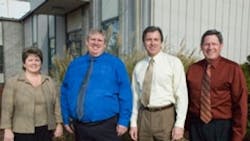Purdue University, West Lafayette, Indiana
In 2008, the Building Services department at Purdue University began creating a comprehensive, three-part sustainability program that wasn’t focused simply on green cleaning. Prior to 2008, there was no emphasis whatsoever on being green; cost impact factors drove nearly every decision. With the implementation of this new concept, the school charted a five-year course for the department to bring it to the forefront of the sustainability movement and establish it as a “best practices” model. Phase I incorporated environmentally friendly cleaning, floor and carpet care, consumables and special project support. Phase II incorporated deskside recycling. Phase III is focused on third-party certification for the department. The parameters of the program overlap into contracting, purchasing and maintenance practices, and it contributes significantly to the university’s five-year strategic plan, New Synergies.
The cleaning program is built around the premise that being Green Seal-certified is not enough. The program looks at the entire life cycle of the products and processes. Everyone is involved: staff, customers, student organizations, individuals and vendors. The university leverages industry innovations and incorporates improving technologies to advance the effectiveness of the program, such as like bio-augmented chemicals and ionized water. It looks for safer alternatives by balancing decisions to use a product with commitments to capture available opportunities to protect the environment.
In doing so, Purdue is striving to reduce its overall ecological footprint. It wants to eliminate all use of potentially harmful products based upon their sensitization, toxicity and bioaccumulation. It wants to position the building services department to support LEED buildings, and provide staff and customers with the safest, healthiest and cleanest environment possible. To evaluate whether it is reaching that goal, it uses a computerized workloading and inspection program, as well as monthly sampling of customer satisfaction by electronic survey.
Throughout the research, development and implementation of the program, the university has sought to be innovators and leaders. When it first started research, it found very few peer institutions actively engaged in a comprehensive approach. Even today it sees more investigation than implementation. Purdue is the first of the Big Ten schools to decide on a three phase program--cleaning, recycling and certification--to compound the benefits. It is the first of the Big Ten schools to focus on bio-renewable products and chemicals across the board. We are the first Big Ten schools to attempt to reprogram human behavior by removing the ubiquitous deskside trash can entirely and replacing it with a comingled recyclables container. It also is among the first schools to openly partner with manufacturers to promote the approach and aid in the development and marketing of enhanced green products, some of which are now available in the marketplace.
Purdue has established a standing committee representing all the campus organizations that provide custodial services. This team of management representatives is involved directly with contracting, purchasing and use decisions, thereby ensuring a high degree of coordination across the university when it comes to providing custodial support. This command team enjoys the direct support of the executive vice president of the university, and participated directly in the recent organizational review of custodial services at Purdue. This review led to the finding that Building Services provides a level of service that exceeds industry standards while using just 79 percent of the staffing and resources of peer institutions across the country. This, in turn, resulted in the decision not to outsource custodial services, which preserved some 700 positions across campus.
The impact of the program has been dramatic, far-reaching, and more important, sustainable. For the first time in its history, Purdue has demonstrably reduced its year-to-year environmental impact. Some of the more significant results documented thus far:
-A reduction in the number of different chemicals used to clean from 93 to 32, with 10 of these occasional-use products only.
-A reduction in the number of cleaning products identified as presenting respiratory hazards from 36 to 2.
-A reduction in the number of cleaning products that emit low volatile organic compounds from 16 to 0.
-A reduction in the number of products containing wastewater contaminants from 20 to 2.
-A reduction in the variety of can liner sizes from 10 to 5.
-An increase in recycled content of paper towels from 50 to 70 percent, and in toilet paper from 70 to 90 percent.
-A reduction in worker’s compensation claims from an average of 10.3/month to 3.6/month.
-Annualized S&E costs have dropped by 20 percent.
-This past year, Purdue transported to the local landfill the lowest tonnage of solid waste on record. In two years, it has cut the amount of trash sent to the landfill from more 8,080 tons to 4,582 tons, a 43.3 percent reduction by weight. Every ton diverted away from the landfill saves the university money in tipping fees.
Story of innovation—Waste diversion: This past year, Purdue transported to the local landfill the lowest tonnage of solid waste on record. In two years, it has cut the amount of trash sent to the landfill from more 8,080 tons to 4,582 tons, a 43.3 percent reduction by weight. Every ton diverted away from the landfill saves the university money in tipping fees.
Program Information
Number of students: 40,000
Square footage maintained: 9.7 million
Number of full-time custodians: 321
Annual cleaning budget: $9,034,000
Green cleaning team members: Terry Ashlock, Director of Bldg. Svcs.; Bob Morman, General Mgr.
